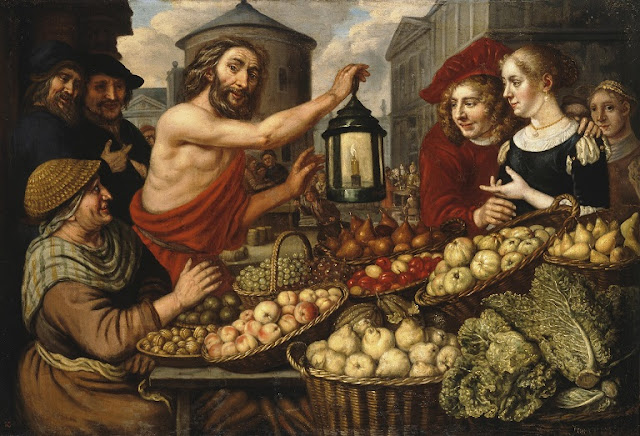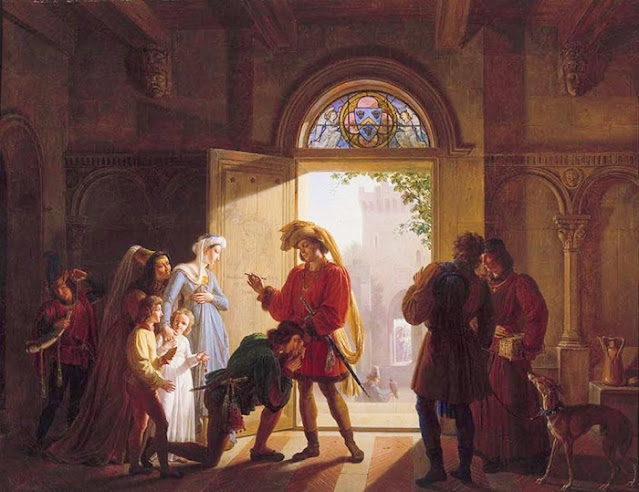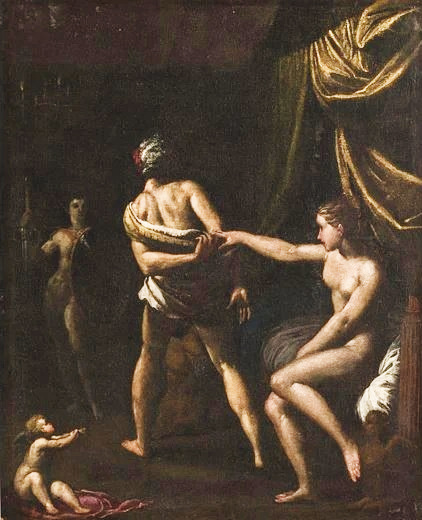Jan Victors (Dutch, 1619 - after 1676)
The Angel Taking Leave of Tobit and His Family, c. 1649
Oil on canvas
104.1 × 131.8 cm (41 × 51 7/8 in.)
After curing Tobit's blindness, returning the family's wealth, and making it possible for Tobit's son Tobias to marry his beloved Sarah, the Archangel Raphael has dropped his disguise and revealed himself as an angel, saying, "I was not acting on my own will, but by the will of God." Such a scene of miraculous intervention was especially attractive to Protestants in Holland, who believed in doctrines of faith, mercy, and divine grace.
Jan Victors took his subject from the Book of Tobit, among the Apocrypha in the Old Testament. Borrowing elements from his teacher Rembrandt van Rijn's 1637 rendition of the subject, Victors set his figures before and within an architectural setting and opened the composition to a clouded landscape on one side. Strong contrasts of light and dark and a foreshortened angel, flying away on a diagonal and viewed from the back, give the scene animation and urgency. Victors's characteristically careful interpretation of surface details includes beautifully rendered highlights on the costumes and Tobias's head. More on this painting
Jan Victors or Fictor (bapt. June 13, 1619 – December 1679) was a Dutch Golden Age painter mainly of history paintings of Biblical scenes, with some genre scenes. He may have been a pupil of Rembrandt. He probably died in the Dutch East Indies.
Jan Victors (1619–1676)
Esau Sells Jacob the Right of Seniority for a Bowl of Lentils, c. 1653Oil on canvas
109 x 137 cm
Royal Lazienki Museum, Warsaw
In Genesis, Esau returned to his brother, Jacob, being famished from the fields. He begged his twin brother to give him some "red pottage". Jacob offered to give Esau a bowl of Lentils in exchange for his birthright (the right to be recognized as firstborn) and Esau agreed.
Esau acts impulsively: "Esau demonstrates that he does not deserve to be the one who continues Abraham's responsibilities and rewards under God's covenant, since he does not have the steady, thoughtful qualities which are required... Jacob shows his willingness as well as his greater intelligence and forethought... What he does is not quite honorable, though not illegal. The title that he gains is at least partially valid, although he is insecure enough about it to conspire later with his mother to deceive his father so as to gain the blessing for the first-born as well." More on Jacob and Esau

Jan Victors (1619–1676)
Jacob Seeking the Forgiveness of Esau, c. 1652
Oil on canvas
70-1/4 x 81-1/2 in.
Indianapolis Museum of Art
When they grow older, Jacob, with the help of his mother Rebekah, tricks his father Isaac into blessing him, instead of his older brother. Discovering this duplicity, Esau then swears that he will kill his brother after their father dies. So Jacob flees, again with help from his mother, to live with his Uncle Laban in Haran. There Jacob marries Laban’s daughters Leah and Rachel, takes concubines, and has 12 sons and one daughter. Jacob prospers, but finally, at God’s behest, Jacob leaves Haran to return to the land of his birth, where he must confront his brother.
The subject of this painting is taken from the book of Genesis and depicts the moment before the reconciliation of the brothers, Jacob and Esau. Following the biblical text, Jacob has divided the children of his two wives and his handmaids, putting the latter in front. He asks for forgiveness from Esau who, unseen in this painting, advances at the head of four hundred men. The principal characters in this drama are portraits of an unidentified family. More on Jacob Seeking the Forgiveness of Esau

Victors, Jan (1619-po 1676)
Joseph’s Bloodied Coat is Shown to Jacob, c. 1649
Oil on canvas
96,9 x 112,9 cm
The Old Testament story of Joseph fueled the imagination of Dutch artists, not only for the marvelous exploits of the young leader, but also for the jealousies, deceits and betrayals that mark the complex narrative of his life.1 The cause of many of those jealousies was the coat of many colors that his father, Jacob, had presented to him as a sign that he was the favored son. The tragic consequences, when Joseph’s brothers turned against him. His brethren conspired to kill him. However, Reuben, one of the brothers, dissuaded them from committing fratricide and, instead, they threw Joseph into a pit. Although Reuben intended to rescue Joseph and return him to his father, Joseph was taken to Egypt after the others sold him to passing Ishmaelites for twenty pieces of silver. Reuben, upon discovering that Joseph was missing, then conspired with his brothers to deceive Jacob into believing that Joseph had been eaten by a wild beast. To feign his death they dipped Joseph’s coat in the blood of a goat, which they then took to the aged patriarch. Seeing the bloody coat, Jacob tore his garments in grief, donned sackcloth, and, taking no comfort in his family’s consolations, mourned Joseph’s loss. More on Joseph’s Bloodied Coat
Jan Victors (Dutch, Amsterdam 1619–1676/77 East Indies)
Abraham's Parting from the Family of Lot, ca. 1655–65
Oil on canvas
58 x 65 1/8 in. (147.3 x 165.4 cm)
Abraham and his nephew Lot have journeyed from Egypt to the plain of Jordan, where there is a dispute between their respective herdsmen about grazing land. Abraham generously tells Lot to choose whatever territory he would prefer.
In the painting, Lot's well-known strain of weakness is written plainly on his face and in his posture. Like his daughters, who will eventually seduce him, Lot sits idly at the dinner table, while Abraham, in a fur-lined robe, gestures with Mosaic decisiveness. Lot's wife, who later becomes the pillar of salt, appears to smile at the patriarch's largess. In the background, herders debate the issue, while sheep as thick as cotton graze the land that was "not able to bear them". More on this painting
Victors only painted scenes from the Old Testament, which distinguishes him among contemporary Dutch artists, who, as protestants, did not altogether abandon painting Christological subjects, although they painted Old Testament themes more frequently. According to Debra Miller, the reason for such an approach should be sought in Victors’ orthodox Calvinism, which is why he remained strictly within the rules for the veneration of religious images. The painter was more interested in the underlying didactic meaning of his compositions than in their artistic merits. Victors’ idea was that his Old Testament paintings were to be an interpretation of the biblical content that was as accurate as possible.
Jan Victors (Dutch, Amsterdam 1619–1676/77 East Indies)
Market Scene with a Quack at his Stall, c. 1650
Oil on canvas
79 x 99 cm
Szépmûvészeti Múzeum, Budapest
This painting was painted about 1650 but the style and manner of presentation are those of an earlier period. This was the beginning of the great period of middle-class genre painting when artists were developing a style quite different from Victor's over-familiar anecdotical approach.
The market-place is in fact limited to the quack's table with an awning over it, and the group of simple people crowding round the stall. The church and houses round the market-square are outlined behind the group of onlookers and the village street with figures can be seen in the distance. The peasant sitting barefooted, one of his shoes discarded beside him, the charlatan in his finery, and the colourful company of villagers around them are characters in an anecdotical story which is indeed worthy of the painter's brush. Victors was a pupil of Rembrandt, and his figures are clearly derivative but they are smooth and superficial compared with the character studies of the great master. More on this painting

Victors, Jan. 1619-1676
Diogenes with a Lantern at a Market Square, c. second half of the 1650s
Oil on canvas
109,5x160 cm
Diogenes of Sinope (l. c. 404-323 BCE) was a Greek Cynic philosopher best known for holding a lantern (or candle) to the faces of the citizens of Athens claiming he was searching for an honest man. He rejected the concept of "manners" as a lie and advocated complete truthfulness at all times and under any circumstance. More on Diogenes
Jan Victors
Nourrir les orphelins/ Feeding the orphans, c. 1659-1560
Oil on canvas
146 x 221 cm,
Musée Historique d'Amsterdam, Amsterdam
Victors, Jan. 1619-1676
Ferry, c. 1660s
Oil on canvas
85x118 cm
The State Hermitage Museum
The representation of a ferry transporting peasants and livestock is the most favourite subject in Jan Victors’ oeuvre. As D.Miller [1985] notes, such outdoor anecdotal genre scenes were much sought after in the art market and were quite often copied by the artist’s contemporaries. Out of the six works by Victors on this subject, the only piece with the author’s date (1653) is displayed in the National Museum in Poznan. Some characters present in the Hermitage painting – a boy trying to catch a duck, a young peasant woman in a boat - harken back to the master’s earlier canvas. (Walker Art Gallery, Liverpool). In D. Miller’s opinion [1985], a group of paintings representing ferry crossing was probably created in 1646–1654. More on this painting
Jan Victors (1619–1676)
Young woman at a window, c. 1640
Oil on canvas
Height: 93 cm (36.6 in); Width: 78 cm (30.7 in)
Louvre Museum
Victors was born in Amsterdam. He was described in a Haarlem tax listing in 1622 as a student of Rembrandt van Rijn. Though it is not certain that he worked for Rembrandt, it is clear from his Young girl at a window (See above) that he had looked carefully at Rembrandt's paintings. He was only twenty when he painted this scene, and the look of expectation on the girl's face shows a remarkable study of character. He seems to have abandoned painting well before the rampjaar of 1672, when, like many painters in Amsterdam, he fell onto bad times and took a position as ziekentrooster ("comforter of the sick"), a role as professional nurse and cleric, with the Dutch East India Company in 1676. He probably died soon after arrival in Indonesia, then the Dutch East Indies. More on Jan Victors
Please visit my other blogs: Art
Collector, Mythology, Marine
Art, Portrait of a Lady, The
Orientalist, Art of the Nude and The
Canals of Venice, Middle
East Artists, 365
Saints and 365 Days, also visit my Boards on Pinterest
Images are copyright of their respective owners, assignees or others.
Some Images may be subject to copyright
I don't own any of these images - credit is always given when due unless
it is unknown to me. if I post your images without your permission, please tell
me.
I do not sell art, art prints, framed posters or reproductions. Ads are
shown only to compensate the hosting expenses.
If you enjoyed this post, please share with friends and family.
Thank you for visiting my blog and also for liking its posts and pages.
Please note that the content of this post primarily consists of articles
available from Wikipedia or other free sources online.






































